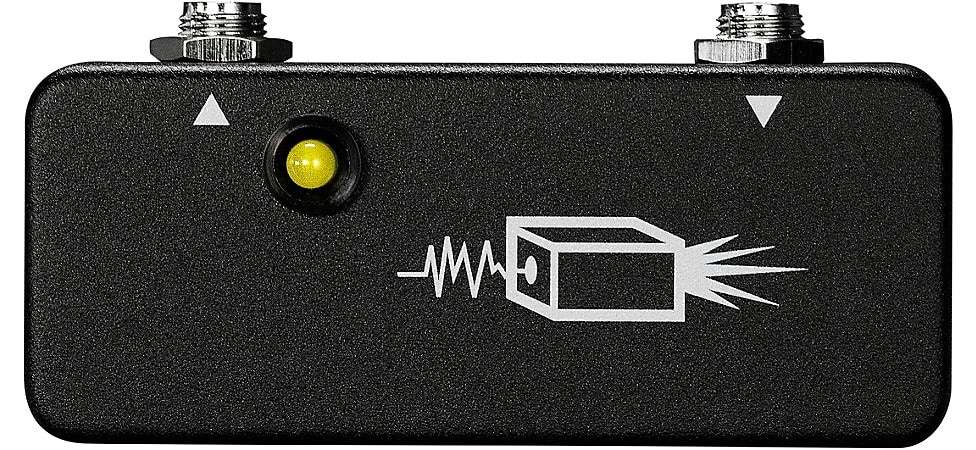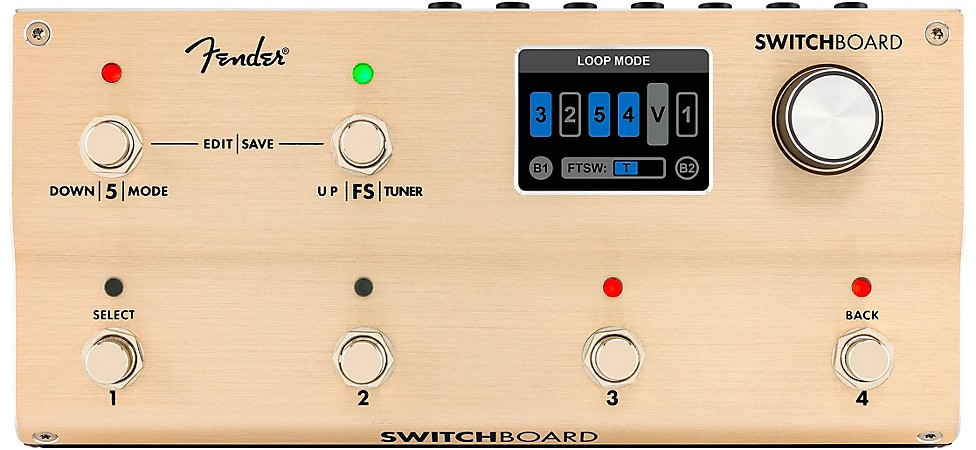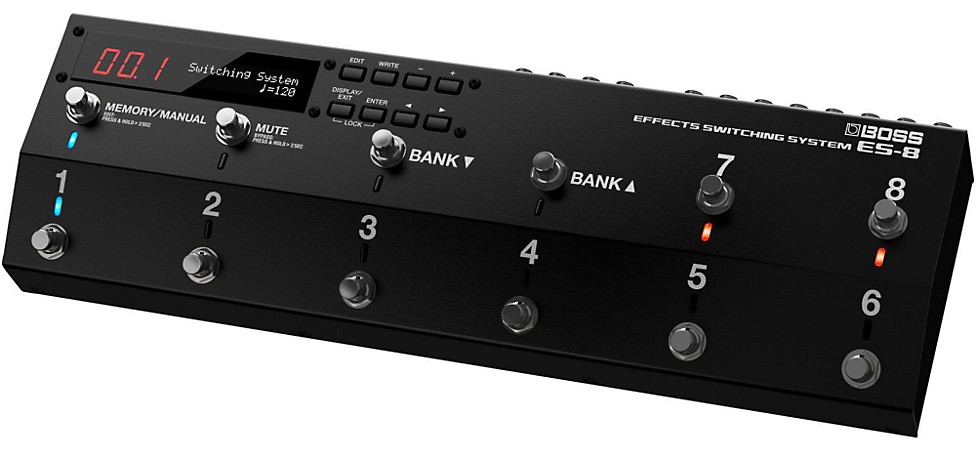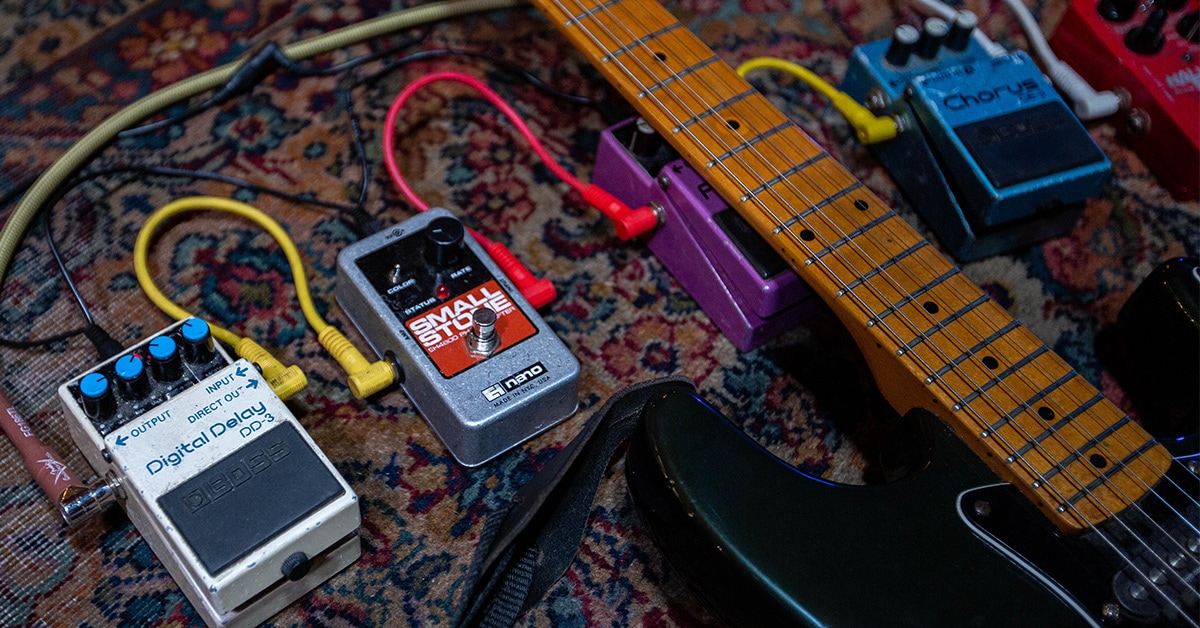If you’ve ever watched a roomful of guitarists argue whether a wah pedal should go before or after distortion on a pedalboard and secretly felt a little lost, you’re not alone.
Signal chain, or the way a guitar’s signal travels from pickups to amp, is a passionate topic among many players. Discussions over the relative importance of true bypass, effects loops, cable length and more can easily wander into the weeds and leave you wondering how big of a difference any of it could possibly make. One of the most common questions tinkering guitarists find themselves asking is, "What is the best pedal order? Where do I even start?."
The truth is, of course, complicated. The order of your pedals and the way your signal travels to your amp can make an enormous difference. At the same time, while there are certain foundational concepts, there are no hard-and-fast rules. It’s ultimately up to your ears.
Guitarists who use pedals often begin in a kind of honeymoon phase, head over heels in love with how one particular effect enhances their sound. As those pedals begin to accumulate, it gradually becomes clear that they have to somehow work in relationship with one another.
That’s when the questions begin. “How do I power all of these?” “Why did it sound different yesterday?” “Where the heck is the delay pedal?” “Do I need a pedalboard for this mess?”
A key step in getting your pedals organized is understanding how they work in relationship with one another, and how they can color your signal even when they’re powered off.
Today, we’ll take a look at the basic concepts of pedal order and how it affects your guitar signal. Along the way, we’ll try to demystify some of the jargon around it.
Table of Contents
Common Guitar Pedal Orders
Straight Into Input
Using an Effects Loop
What Can Cause Signal Loss In Your Pedalboard?
What Are the Different Types of Bypass?
Switchers
A Guitar Pedal Primer
The Best Pedal Order Is the One You Choose
Common Guitar Pedal Orders
Traditionally, guitarists hit their amplifiers with their effects signal chain by running directly into the amp input jack. In recent years, the advent of amplifier effects loops have given players more versatility in choosing what effects impact the amp in what way.
When we run from guitar through pedals straight into our amp’s input, this means everything hits the front of the amp. Why does that matter? If you’re overdriving your amp itself, then every effect that hits it will also be overdriven.
Straight Into Input
The most common pedal order when running directly into your amp input is:
Guitar —> Tuner —> Pitch —> Wah or Phaser —> Dynamics —>Volume Pedal —>Boost —> Gain —> Filter/EQ —> Noise Gate —> Modulation —> Time-Based —>Looper —> Amp
This order follows how effects color the effects that follow them.
Putting your pitch-adjusting pedal at the front allows it to have the purest signal possible to change, meaning accuracy in those harmonies and octaves.
Placing wah before distortion and gain-based effects means your wah pedal has more intricate harmonics to play with.
Dynamics pedals like compressors live before volume pedals because there’s not much sense in having a volume pedal if your compressor is going to counteract it.
Similarly, volume comes before gain-based pedals so that their boost comes on top of the volume you already have set.
Noise gates live after gain-based pedals to compensate for the added buzz and hum that these pedals give that you might not always want.
Delay pedals, reverb and loopers come at the end of the chain because you will typically want them to repeat and color all the effects you’re playing.
As with all things guitar, this is a topic of fierce debate, with many experts claiming certain “correct” pedal placement methods. One of the hottest topics is where modulation and time-based effects live in relation to other pedals. Some players prefer how distortion darkens their delay, while others hate the way it changes the decay of signal.
While the order we’ve listed is the most common, we can guarantee you’ll come across a player with wah at the end and fuzz right after the tuner.
Using an Effects Loop
There are two types of effects loops: series and parallel.
In series, the entire sound coming from your preamp passes through the effects loop and then on to the next stage.
In parallel, there are two signals sent to the power stage—the unprocessed signal from your preamp, and the processed signal from the preamp to the effects loop.
The pedal order for an effects loop begins the same:
Guitar —> Tuner —> Pitch —> Wah or Phaser —> Dynamics —> Volume Pedal —> Boost —> Gain —> Filter/EQ —> Noise Gate —> Looper —> Amp Input
Connected separately to your amp’s effects loop are your remaining effects in this order:
Amp Effects Loop Send —> Modulation —> Time-Based —> Effects Loop Return
You can see that the overall pedal order is the same. The only difference is where we split off to the effects loop. Why does this make a difference? Modulation and time-based effects can sound dull if they hit your amp before your overdriven preamp distorts it. By removing them from the chain and putting them after your preamp, they retain their high end and clarity. Some players put their EQ pedals in the effects loop chain to shape the tone of their overall sound with more detail.
What Can Cause Signal Loss In Your Pedalboard?
With so many stops and bypasses on the way from guitar to amp, it’s easy to see that your signal might lose a bit of its power and, to be honest, tone. The simplest reason for this is that the longer the distance your signal has to travel, the more it’s going to degrade. This is thanks to capacitance buildup along your cable run. This usually results in a loss of high frequencies and overall clarity or “cut.” It’s important to start your chain with the shortest cable you can comfortably use, because the shorter the distance between connectors/conductors, the stronger the signal passed along. Also, using cables with low capacitance makes a big difference.
What Are the Different Types of Bypass?
As you have added pedals to your board, you may have noticed a drop-off in tone when certain pedals are switched off. This is where bypass comes into play, and where we learn that “true bypass” is more than just a buzzword used by pedal builders.
There are three types of bypass that pedals use to pass along a signal when they’re turned off.
Standard, or traditional bypass allows your signal to travel from the input through the entire circuit of the pedal before hitting output. This impacts the overall impedance and, as a result, your tone, making it marginally weaker and muddier.
True bypass ensures that your signal travels from input directly to output, bypassing the pedal circuit completely, and leaving your impedance unaffected.
Buffered bypass is where things get really interesting. This inserts a buffer into the signal path, like a rest stop on the highway. A buffer is a circuit that allows you to minimize any high-impedance load, and has a low-impedance output to avoid signal degradation along the next steps in your signal chain.
It does what now?
It preserves your tone as-is and strengthens it for the journey down the line.
While some pedals come with built-in buffered bypass, you can also purchase buffer pedals independently. Sometimes they’re paired with a boost circuit to further improve your signal chain. It’s worth trying out a buffer pedal in different places along your pedal chain to see how it impacts your sound. For instance, a buffer before a fuzz may result in a thin, weak, fuzz effect.
Independent buffer pedals to consider include the JHS Little Black Buffer, JHS Prestige Buffer and Boost Xotic Super Clean Buffer and the Old Blood Noise Endeavors EQ + Buffer.

Pictured: JHS Little Black Buffer
Switchers
Integrating a switcher into your rig is a relatively convenient method of handling multiple effects, allowing you to change the signal flow of your pedals and create “patches,” where you can engage or disengage groups of stompboxes with a single switch. The Fender® Switchboard Effects Operator is a fine example of this concept—complete with five rearrangeable effects loops, you can streamline your pedalboard with intuitive routing at your feet and fingertips.

Pictured: Fender Switchboard Effects Operator Switcher Pedal
The BOSS ES-8 offers another means of reinventing your sound with its ensemble of eight utilitarian effects loops, encouraging users to explore the order of their pedals, as well as the combination of sounds that distinguishes their unique voice.

Pictured: BOSS ES-8 Effects Switching System
The EHX Super Switcher, the Voodoo Lab PX-8 PLUS and the smaller footprint EarthQuaker Devices Swiss Things are a sampling of other great options on the market, too. Switchers enable you to take control of your pedalboard in an all-new fashion, so you can forgo your tap-dancing days and forget about constant rewiring—the pedal switcher becomes the central nervous system of an inspirational creation station.
A Guitar Pedal Primer
A quick unscientific study shows that there are roughly forty bazillion types of effects pedals a player can choose from. Our guide to guitar pedals is an introduction to which pedals do what, and why.
When you’re thinking about what order to put them in, it’s important to think about how they operate. These are the common pedals that play a big part in your signal chain.
Wah: The wah wah pedal got its name from how it sounds. Originally marketed to mimic the vocal-like sound of a trumpet's plunger mute, the first wah, the VOX V846, was based on the mid boost circuit of a VOX Super Beatle amp. Trumpet players mostly ignored it, but it struck a resonant chord with '60s rock musicians. This pedal is a tone filter that lets you adjust the highlighted frequency of your sound from bass to midrange to treble. The more harmonic color it has to play with, the more powerful the effect.
Filter/EQ: Equalizer pedals and filter pedals exist to fine-tune your tone by adjusting the levels of individual frequencies. They can also sometimes affect the volume of your signal, especially when they come after a gain-based effect like a booster or overdrive.
Dynamics: Compressor and sustainer pedals are the most common dynamics effects pedals. Compressors level the dynamics of your signal. This way, very soft playing is boosted and doesn’t get lost, and very hard playing is leveled down to keep from overpowering the ear or your gear. This can dramatically change the sound of gain-based pedals and often appears before them on a pedalboard.
Boost: Boost pedals are handy for solos or highlighted sections of songs, but they’re also useful in giving your guitar’s signal a bump to push through your signal chain a little harder. This can change both the sound and responsiveness of other pedals.
Gain-Based Effects: Overdrive, distortion and fuzz are the prime examples of gain-based pedals. While they respond to playing dynamics differently, they all pour a heap of gain on your signal to achieve that crunchy clipping we all crave. These typically come after filters and EQs to benefit from your desired tone. It’s also worth noting that some fuzz pedals, like the Fuzz Face, have a low input impedance, making them ideally suited for the first spot in your signal chain.
Noise Gate: Noise gate pedals cut out hums, buzzes and unwanted tones that often pop up as a result of all these little detours your signal makes on its way from the axe to the amp. Where it sits in your pedal order ultimately comes from experimentation, but there are some tips we’ll share below.
Volume Pedal: Volume pedals are used to control the signal level at any point in your signal chain, which will impact how hard the next part of your chain is hit.
Tuner: This is going to help get your guitar tuned up fast. Tuners typically sit at the very front of a pedal chain.
Pitch/Harmony: Pedals that adjust your pitch by adding harmonies or octaves need a pretty pure signal to work their best. Distortion and other clipping effects will change how a pitch pedal recognizes the note it’s shifting.
Looper: Loopers allow you to record a section and play it over and over, sometimes layering with even more loops. Where it lives on a pedalboard is ultimately up to how many effects you want on your loop.
Modulation: Chorus, flangers, vibrato and all of the wonderful and often weird modulation pedals change the frequency spectrum of your signal, sometimes adding a smidge of delay to deepen their sound. Where you place them depends on what effects you want to join in the modulation party.
Time-Based Effects: Delay and reverb pedals are beautiful and complicated effects. By repeating a signal with a gradual decay, these pedals are very particular in how they relate to other effects.
Keep in mind that we’re looking at a full signal chain in this article, which means that there are effects listed that you may not currently have. Don’t worry. Just start by placing what you have in the order we recommend and then experiment.
The Best Pedal Order Is the One You Choose
Guitarists, gearheads and tone connoisseurs will continue to argue signal chain forever, and every technical innovation will lead to a new debate. What’s presented here should serve as a springboard for your own ear and expertise. At the end of the day, the best pedal order is the one that sounds good to you. Whether you decide to break convention or go with the flow, organizing effects pedals is simply a matter of taste.
Feel free to experiment with pedal order and new effects in person at the nearest Guitar Center, and, in the meantime, kit yourself out with the essentials: cables, power supplies, pedalboards and, of course, pedals.







